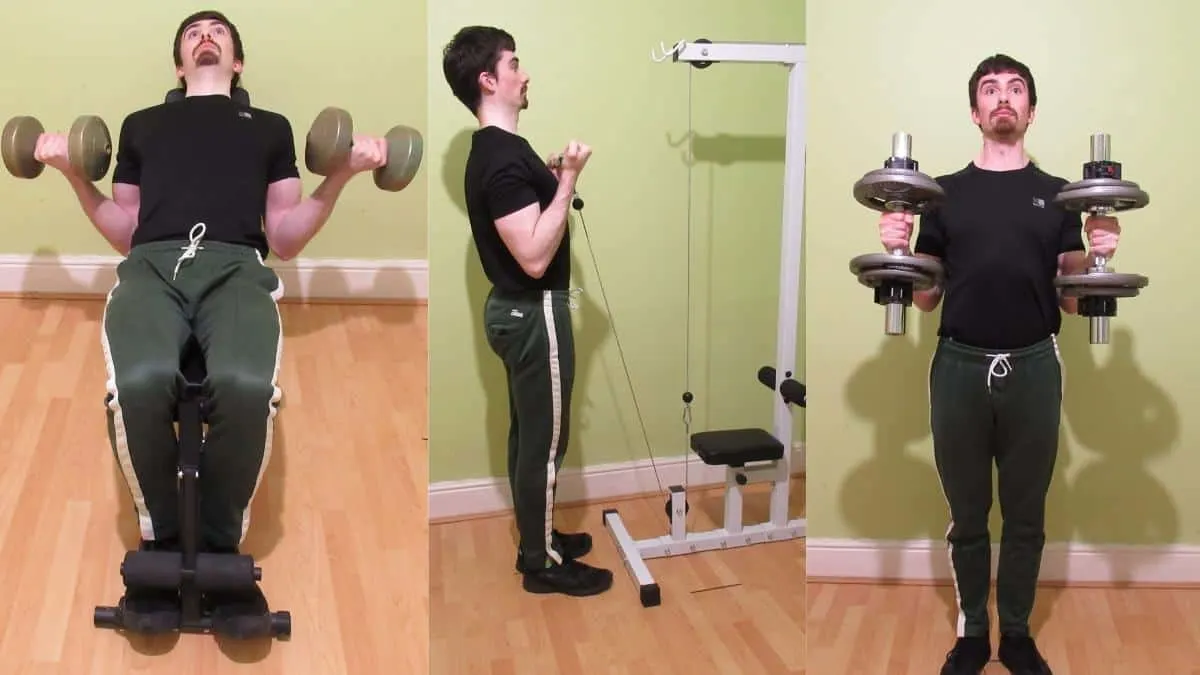There are countless curl variations that work the biceps muscle well. In fact, we tried over 50 different types of arm curls before coming up with our list of the best bicep curl variations.
So if you want to know what the most effective bicep exercises are, then this guide is for you.
You’ll learn the optimal lifting technique for each movement as well as the specific region of the biceps that each exercise emphasizes.
The 17 best types of bicep curls
After experimenting with numerous variations of bicep curls, we created a list of the most effective muscle-building movements for the biceps. So be sure to add some of these curls to your next arm day if you want to grow your bis!
1. Hammer curl
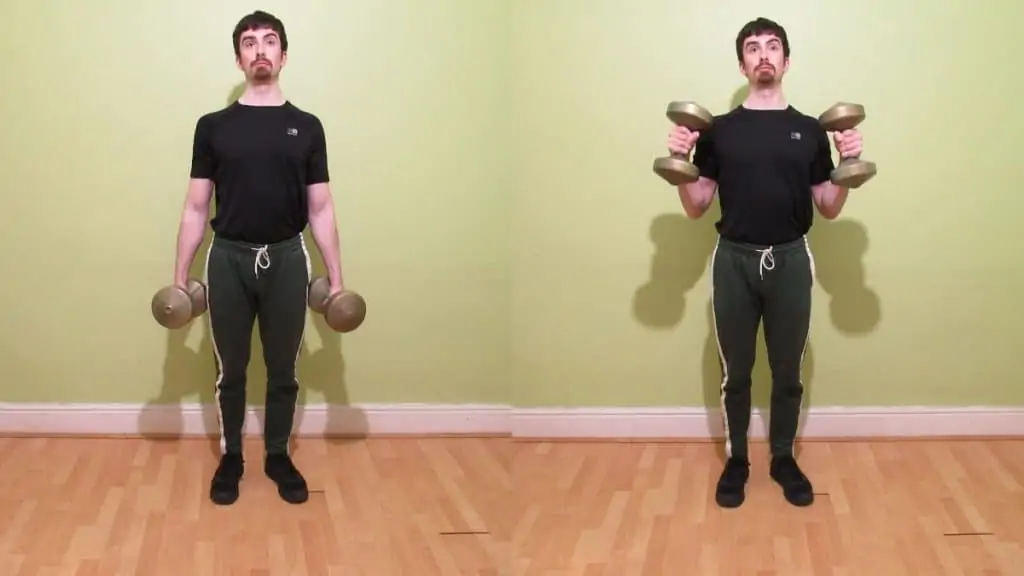
There are a number of hammer curl variations that you can do to build muscle. But the standing hammer curl is by far the most common type. It’s a classic curl variation that “hammers” the brachioradialis and brachialis in addition to the biceps. So if you’re seeking to gain overall arm size, then make sure to include some kind of hammer curl in your routine.
Since hammer curls put the brachioradialis and brachialis in strong force-producing positions, you can naturally lift more weight on this neutral-grip exercise than on regular curls. As such, hammer curls are an excellent exercise for gaining upper arm strength and training the fast-twitch muscle fibers (the fibers that grow the biggest).
- Hold a pair of dumbbells by your sides with a neutral grip.
- Curl the weights toward your shoulders while keeping your elbows still.
- Keep lifting the weights until your forearms make forceful contact with your biceps.
- Hold the contraction for a moment at the top of the rep.
- Lower the dumbbells back down under control until your elbows reach full extension.
- Repeat for 3-5 sets of 6-10 reps.
2. Dumbbell curls
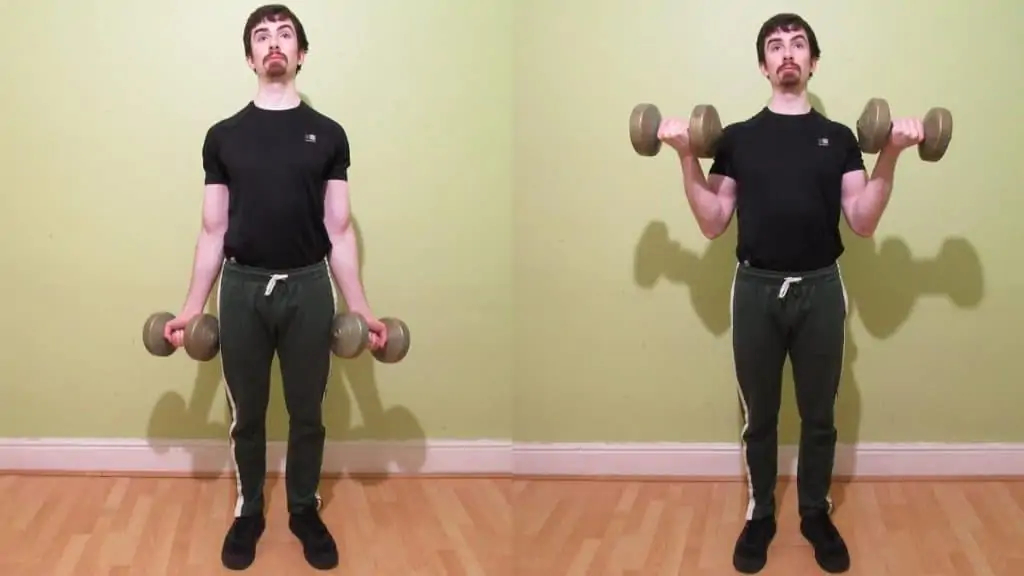
Dumbbell arm curls are another classic bicep-builder that you can do to build strong, symmetrical biceps. Since you have to lift each weight independently when you curl with dumbbells, you can ensure that both of your arms are receiving roughly equal work and are thus growing at similar rates.
Compared to other types of dumbbell curls, the regular standing variation requires minimal equipment and setup time. As such, it’s the ideal exercise to perform if you want to grow your biceps at home because all you need is a basic pair of weights and a small workout space.
- Hold a pair of weights by your sides with a supinated (palms-up) grip.
- Curl the weights toward your front delts while keeping your elbows and shoulders still.
- Keep curling until the undersides of your forearms press right up against your biceps.
- Hold the contraction for a brief moment.
- Lower the dumbbells under control until they’re back by your sides.
- Repeat for 3-5 sets of 8-12 reps.
3. Preacher curls
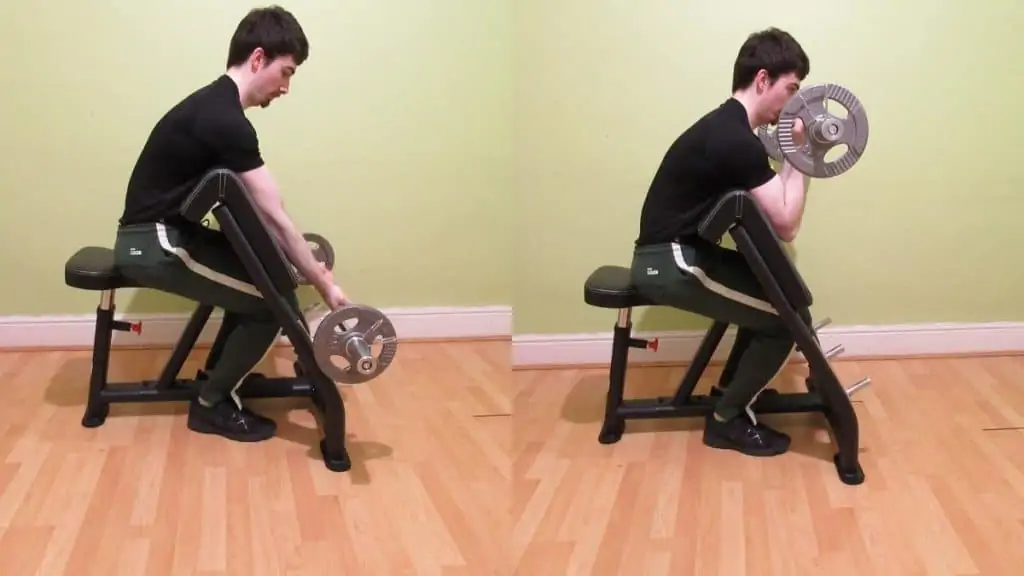
Preacher EZ bar curls target the short head of the biceps by having you curl with your arms in front of your torso. This helps to build the inner part of your biceps, which is the area that people generally see which you flex your arms. Therefore, preacher curls are particularly effective for competitive bodybuilders and anyone else who likes to show off their hard work in the gym.
Unlike some of the other more advanced bicep curls variations, preacher curls are remarkably beginner-friendly (but no less effective for building mass).
This is because when your arms are braced against the preacher pad, you can’t use momentum to swing the weight up. As a result, your biceps are completely isolated and thus have to handle virtually all of the resistance by themselves, which ultimately leads to more muscle growth.
- Place an EZ bar in a preacher curl rack and load some weights onto either side.
- Sit on the preacher curl station’s seat and then grab the bar with a shoulder-width underhand grip.
- Curl the bar toward your shoulders until your forearms make firm contact with your biceps.
- Hold the contraction for a moment, and then lower the bar back down until your elbows are fully locked out.
- Perform 3-5 sets of 8-12 reps.
4. Barbell curls
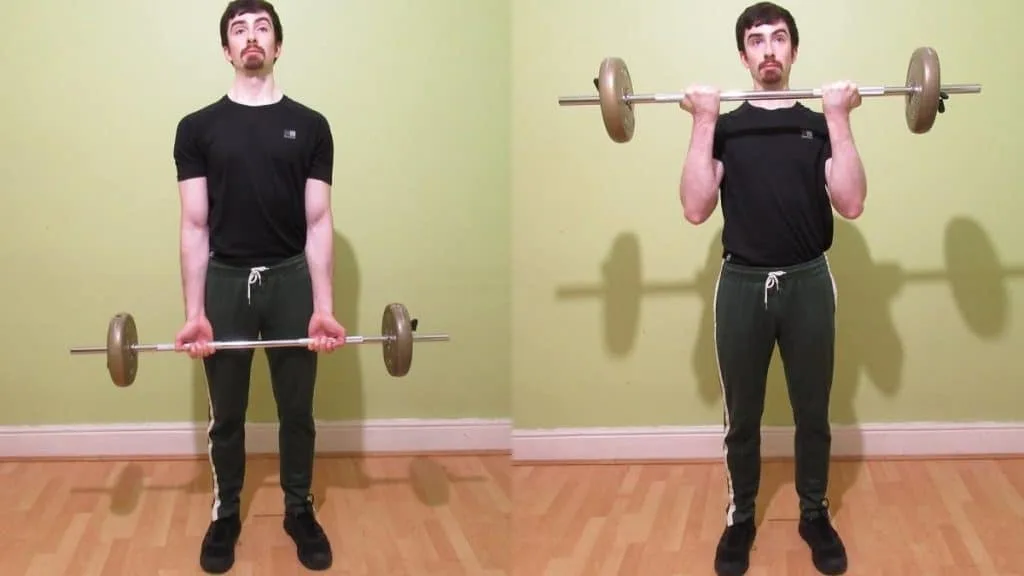
Out of the many different types of bicep curls, the BB curl exercise may well just be the best mass-builder of the lot. This is the case for two reasons.
First off, barbell curls train both bicep functions (elbow flexion and forearm supination) simultaneously and optimally, and they do so throughout the whole duration of the rep.
Second, curling with a straight bar enables you to overload your biceps with more resistance than when you curl with dumbbells. And, all else being equal, lifting heavier weights will trigger more muscle growth.
The downside, of course, is that you might develop muscular imbalances if you perform barbell curls exclusively. Therefore, your best bet for building overall bicep size and symmetry is to include different bicep curls in your routine that use both dumbbells and bars.
- Load some weights onto a straight bar and grab it with a shoulder-width underhand grip.
- Curl the bar toward your chest while keeping your elbows stationary.
- Keep lifting the weight until your forearms push right up against your biceps.
- Squeeze your biceps forcefully at the top of the rep.
- Lower the bar back down until your elbows reach full extension.
- Repeat for 3-5 sets of 6-12 reps.
5. Concentration curls
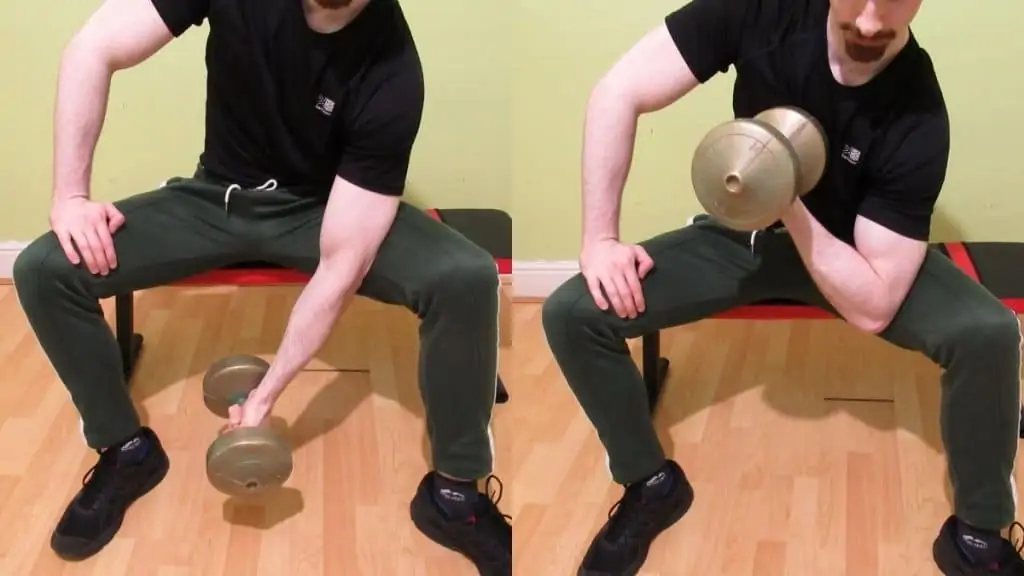
Learning how to do concentration curls properly will help you to build biceps that are not only big and strong but symmetrical too. Unlike with other dumbbell curl variations, you’re training each arm separately when you perform concentration curls.
This means that your brain only has to focus on moving one limb at a time, and so you don’t have to split the neurological resources of your central nervous system over two arms. In other words, you can dedicate 100% of your body’s available strength, focus, and effort to working each individual bicep.
So if you have some significant size or strength disparities between your biceps—or if you want to prevent them from cropping up in the future—make sure to perform some dumbbell curls variations that let you train each arm separately.
- Grab a dumbbell with an underhand grip and then sit on the edge of a weight bench.
- Bend over slightly and then rest the arm that’s holding the weight on the inside of your thigh.
- Hold onto your other knee with your spare arm for support.
- Let your arm fully extend so that the dumbbell is close to the floor.
- Curl the weight toward your shoulder until the underside of your forearm makes firm contact with your biceps.
- Squeeze your biceps as hard as you can at the top of the rep (when you can’t lift the weight any higher without your elbow coming off your thigh).
- Lower the weight under control until your arm is once again locked out.
- Repeat with your other arm and do 3-5 sets of 10-15 reps per side.
6. Zottman curls
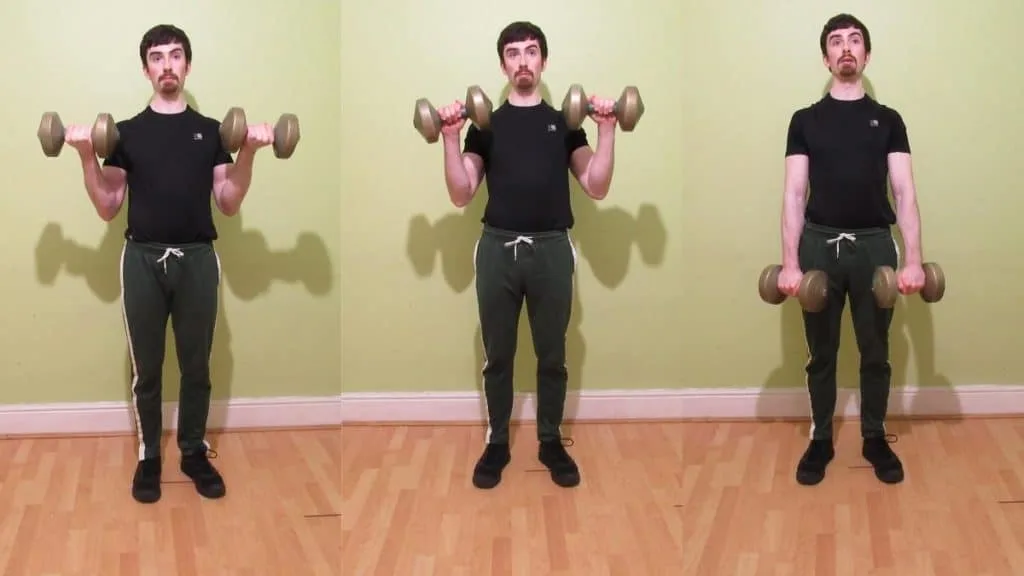
The Zottman curl is one of the best dumbbell curls for building the upper arms and forearms. Unlike some of the other different types of dumbbell curls, Zottman curls train the brachialis and brachioradialis in addition to the biceps.
Essentially, you’re performing a regular curl during the concentric phase of the rep followed by a reverse curl during the eccentric portion of the rep. This enables you to overload your brachialis and brachioradialis during the eccentric—with more resistance than reverse curls—because you can curl more weight with a supinated grip (during the concentric) than with a pronated grip.
- Hold a pair of dumbbells by your sides with a thumbless supinated grip.
- Curl the weights toward your shoulders until your forearms and biceps make forceful contact.
- Rotate your hands into a pronated (palms-down position) at the top of the rep.
- Lower the weights back down with this new overhand grip.
- Turn your hands back to their original supinated position once your elbows are locked out.
- Perform 3-5 sets of 8-15 reps.
7. Spider curls
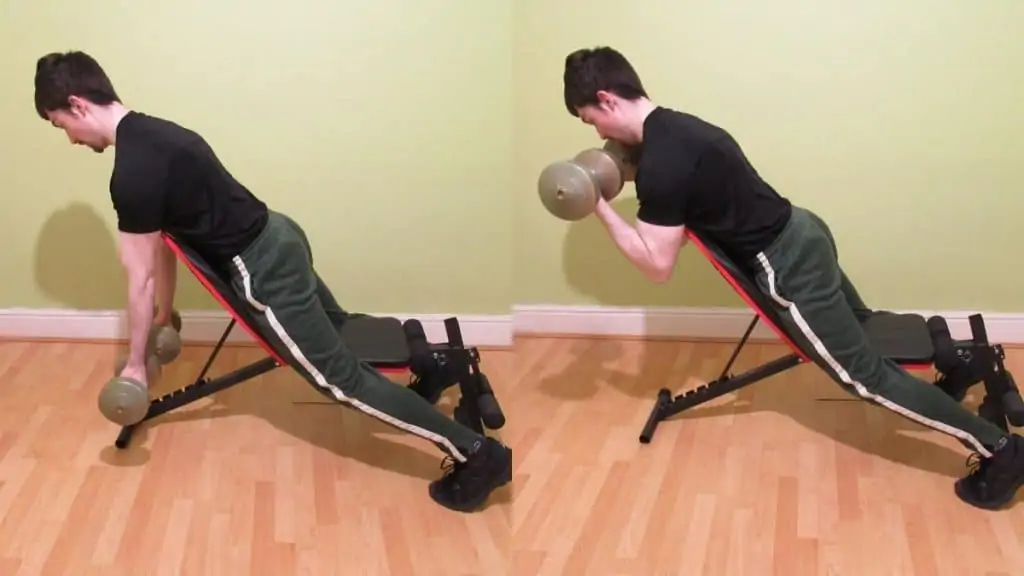
While there are many different kinds of bicep curls that you can do to build muscle, few variations are capable of mimicking the intense peak contraction and muscle pump that the DB spider curl produces.
This is because spider curls train your biceps at a very short muscle length, which is to say when your arms are in front of your body and your shoulders and thus in flexion. As a rule of thumb, bicep curl variations that have you lift the weight in front of your body produce a stronger contraction, a more intense pump, and also emphasize the sort (inner) head of the biceps.
So if you want your arms to look pumped up and vascular while you’re training, make sure to include spider curls or similar types of bicep curls in your routine.
- Set the back pad of an adjustable bench to 60 degrees.
- Grab a pair of dumbbells with an underhand grip.
- Sit on the bench in a reverse position with your torso pressed against the backrest.
- Let your arms extend in front of you.
- Curl the weights toward your front delts while keeping your elbows and shoulders still.
- Keep lifting the weights until the undersides of your forearms make firm contact with your biceps.
- Squeeze your biceps forcefully at the top of the rep and hold the peak contraction for a moment.
- Slowly lower the weights back down until your arms are locked out.
- Perform 3-5 sets of 10-15 reps.
8. Reverse curls
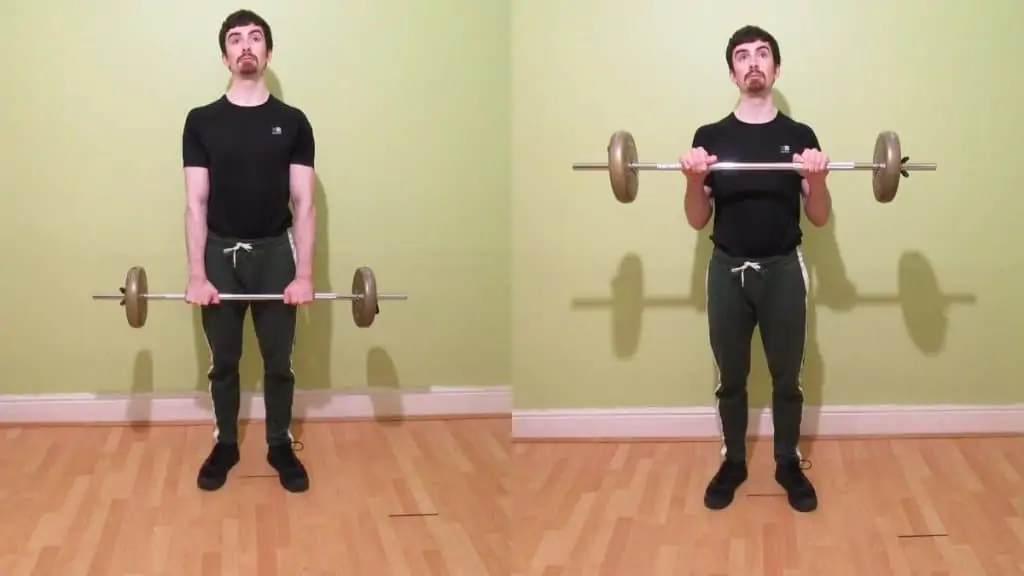
Out of all the dumbbell bicep curl variations, it’s reverse grip bicep curls that are most effective for building the brachialis and brachioradialis muscles.
This is because curling with an overhand grip places the biceps at a mechanical disadvantage.
Therefore, since the biceps can’t produce much force in this position, the brachialis and brachioradialis have to take over the reins and do most of the lifting; hence these two muscles get a great workout from reverse curls.
Since the brachialis lies deeper in the arm musculature than the biceps, making it bigger can actually help to push your biceps out and make them appear more peaked. So if you want to develop an aesthetic pair of arms, then reverse curls should be staple curl variation in your workouts.
- Load some weights onto a barbell and then grab the bar with a thumbless-overhand grip just inside shoulder-width.
- Curl the bar toward your chest while keeping your shoulders and elbows still.
- Keep curling until the tops of your forearms push right up against your biceps.
- Hold the peak contraction for a moment.
- Lower the bar under control until your elbows reach full extension.
- Repeat for 3-5 sets of 10-20 reps.
9. Incline curls
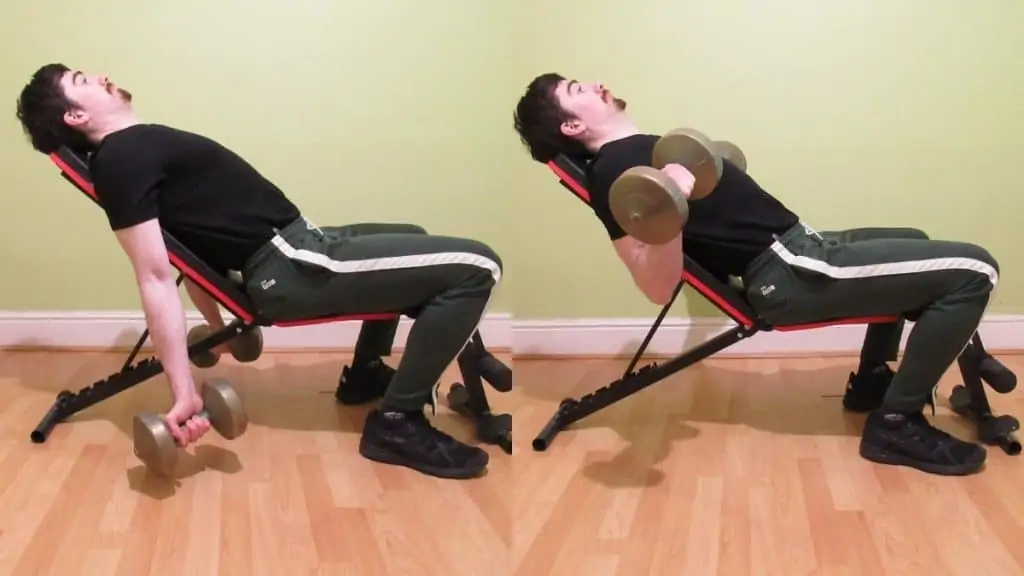
Incline dumbbell curls are one of the best types of bicep curls for developing the long head because they have you curl with the weights behind your hips.
Lifting the dumbbells like this naturally shifts more of the tension onto the outer muscle fibers of the biceps. Developing this area will make your biceps look wider when viewed from the front (especially if your long head is lagging), as well as more peaked when viewed from behind in a flexed position.
- Position the backrest of a weight bench to between 45 and 60 degrees.
- Grab a pair of dumbbells, and then sit on the bench with your back against the pad.
- Let your arms hang slightly behind your torso and hips.
- Curl the weights toward your shoulders while keeping your elbows stationary.
- Keep lifting the weights until your forearms and biceps make forceful contact.
- Squeeze your biceps as hard as you can and hold the peak contraction for a second.
- Slowly lower the dumbbells back down until your arms are locked out.
- Repeat for 3-5 sets of 8-12 reps.
10. EZ bar curls
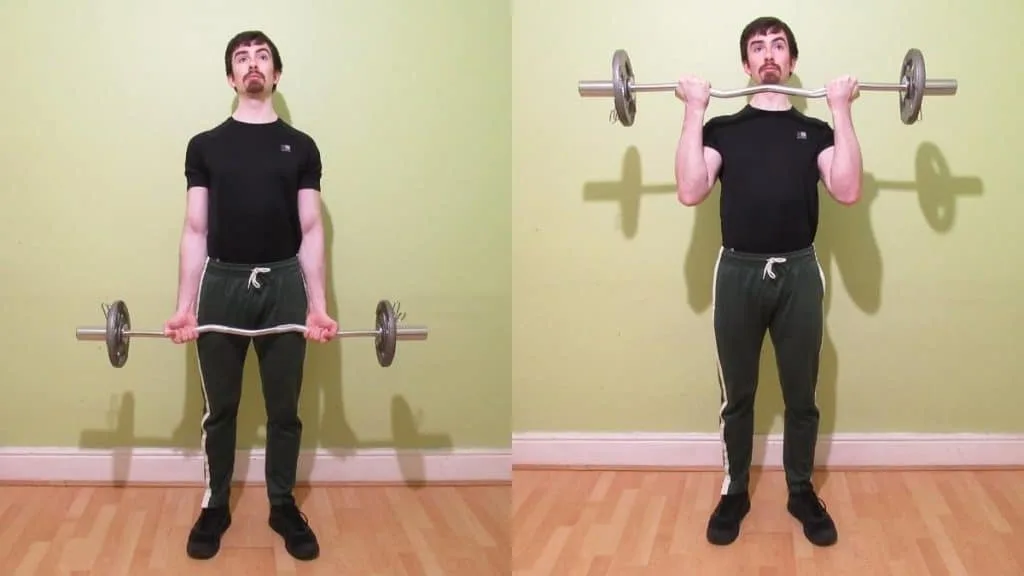
Out of all the types of barbell curls, easy bar curls are the most joint-friendly. This is because EZ bars have semi-supinated grips rather than fully supinated grips.
Therefore, you’ll naturally minimize your injury risk by using an EZ bar because your wrists and forearms won’t be forced into any unnatural or compromising positions.
The only downside is that EZ curls place slightly less tension on the biceps (but more on the brachialis and brachioradialis) than barbell curls because of the semi-supinated grips. However, the difference in muscle activation isn’t significant to the point where you should force yourself to do barbell curls if you find them uncomfortable.
- Load some weight onto an EZ bar. For more convenience, consider using a preloaded bar.
- Grab the bar with a shoulder-width underhand grip.
- Curl the bar toward your chest until your forearms and biceps make firm contact with one another.
- Squeeze your biceps forcefully at the top of the rep.
- Lower the bar back down under control until your elbows reach full extension.
- Repeat for 3-5 sets of 8-15 reps.
11. Drag curls

The barbell drag curl is one of the more old-school bicep curl variations that you can do to build your arms. Not only does this underrated exercise create an intense muscle pump, but it also shifts the tension onto the outer muscle fibers of the biceps by having you drag the bar right against your body and your elbows behind your torso.
Just make sure to avoid shrugging the weight up with your traps. While it’s okay to feel some trap activation due to the fact that you’re essentially rowing your elbows back as you curl, your biceps should still do most of the lifting.
In this regard, drag curls are one of the best types of barbell curls for improving your mind-muscle connection because you really need to focus on squeezing your biceps to get the most from the exercise.
- Load some weights onto a barbell and let the bar rest against your thighs.
- Drag the bar up your body by moving your hands toward your shoulders while simultaneously rowing your elbows behind your torso.
- Squeeze your biceps forcefully as they make firm contact with the undersides of your forearms.
- Hold the peak contraction for a moment.
- Lower the bar back down under control until your elbows are almost locked out (you can use constant tension on drag curls if you’re doing them as a finisher).
- Repeat for 3-5 sets of 10-20 reps.
12. Cable curls
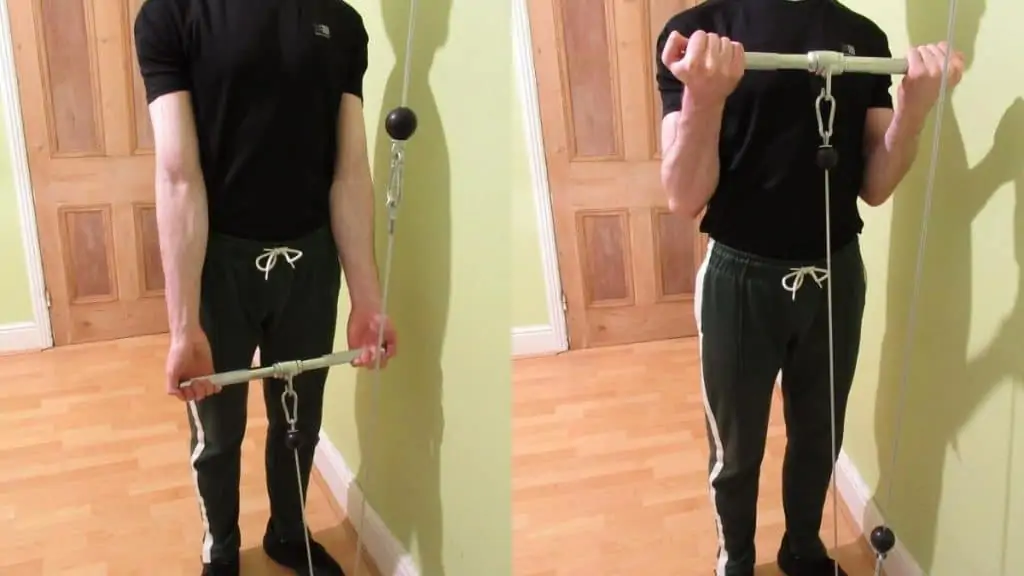
Out of the many different types of bicep curls, low cable bicep curls make your muscles work harder than any other variation on a per rep basis.
This is because, unlike free weight curls, cable curls challenge your biceps with constant tension. So it’s not like your biceps can rest at the bottom of a rep (like they can with dumbbells curls) because the pulley is always exerting some kind of force on your biceps.
Cable curls are typically more joint-friendly than their free weight counterparts because the machine handles some of the stabilization for you. If anything, this makes cable curls better for building muscle because you can dedicate 100% of your attention to simply stretching and squeezing your biceps rather than figuring out how to balance the weight.
- Connect a straight bar attachment to a low pulley.
- Grab the bar with an underhand grip.
- Curl the bar toward your chest by flexing your biceps.
- Squeeze your biceps forcefully as they make firm contact with the undersides of your forearms.
- Hold the contraction for a second, and then lower the bar under control until your elbows are locked out.
- Perform 3-5 sets of 10-15 reps.
13. Seated curls
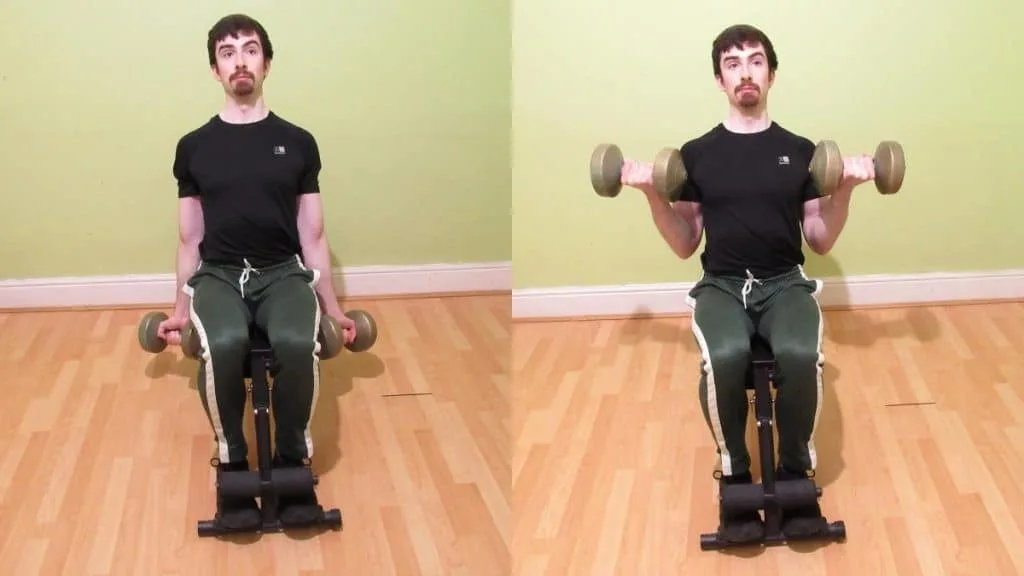
The seated bicep curl is one of the best types of dumbbell curls for hypertrophy training because the sitting position dramatically reduces the exercise’s core stability requirement; hence, you can focus purely on working your biceps.
To get the full benefit of this seated curl, however, you want to actually brace your back against the weight bench’s backrest rather than just perch yourself on the edge of the bench. This is because the back pad helps to stabilize your core so that you can focus on training the target muscles rather than on constantly flexing your abs.
- Set the backrest of an adjustable bench to a 90-degree angle (or somewhere close to it if your bench doesn’t go fully upright).
- Hold a pair of dumbbells with a supinated grip.
- Sit on the bench with your back against the pad.
- Let the weights hang by your sides.
- Curl the dumbbells toward your front delts while keeping your elbows and shoulders stationary.
- Keep lifting the weights until your biceps and forearms make firm contact.
- Squeeze your biceps at the top of the rep and hold the peak contraction for a second.
- Lower the dumbbells back down to your sides in a controlled manner (don’t just let the weights drop).
- Repeat for 3-5 sets of 6-12 reps.
14. Cross body curls
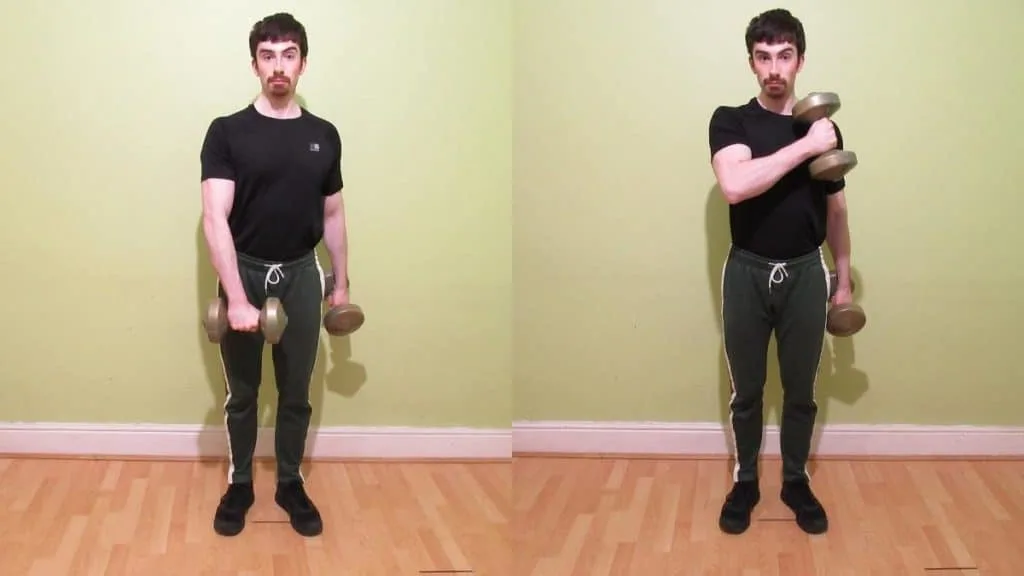
Although there are many different bicep curls out there that can get you those arm gains, few variations enable you to lift as heavy as cross body dumbbell curls.
This is because the cross body curl is a unilateral exercise. And so, when your brain only has to think about moving one arm, you can naturally lift heavier weights because your central nervous system can dedicate all of its strength and resources to contracting that particular bicep.
Also, since you’re lifting the dumbbell across your body rather than toward your shoulder, the long head of your biceps has to do more of the work. So if you want to improve your peak, cross body hammer curls are one way to do just that while also improving your bicep strength.
- Hold a pair of dumbbells by your sides with a neutral grip.
- Lift one of the weights across your body toward your opposite shoulder. Keep your other arm completely still.
- Keep curling until your forearms and biceps press up against each other.
- Hold the peak contraction for a brief moment.
- Lower the dumbbell back down to your side.
- Repeat the motion with your other arm, and do 3-5 sets of 6-10 reps per side.
15. Kettlebell curls

Now that you’ve seen all the different dumbbell curls that you can do, it’s time to learn how doing curls with kettlebells can build your biceps.
Compared to dumbbell curl variations, kettlebell curls place less tension on the forearms. This is because kettlebells are easier to grip than dumbbells since the weighted part is under the handle (and thereby behind your hand when you hold it) rather than at the sides of the handle as with dumbbells.
So if your forearms often fatigue before your biceps when you’re curling, then kettlebell curls will help you to bias more of the tension toward the true target muscle; the biceps.
- Hold a kettlebell in each hand with a supinated grip.
- Curl the kettlebells toward your shoulders while keeping your elbows as still as possible.
- Squeeze your biceps as hard as you can as they make firm contact with your forearms at the top of the rep.
- Hold the contraction for a second.
- Lower the kettlebells back down to your sides in a controlled manner until your elbows reach full extension.
- Repeat for 3-5 sets of 8-15 reps.
16. Resistance band bicep curls

If you don’t have the equipment to try all of the types of dumbbell curls but still want to grow your biceps, then the banded bicep curl is your best friend. Not only do resistance band curls produce a skin-splitting pump that will make your arms look more vascular, but they’re also incredibly joint-friendly since bands are easier to stabilize than free weights.
Additionally, bands are very affordable and highly portable. So if you’re trying to make gains on a tight budget or if you don’t have much space to work out, resistance bands are just about the best piece of equipment you can buy—especially when it comes to the biceps and upper body.
If you only have access to light bands, then you can double loop the band to increase the resistance.
- Grab the band handles with a supinated grip and then stand in the middle of the band.
- Curl the handles toward your front delts while keeping your elbows as still as possible.
- Squeeze your biceps forcefully as they push up against your forearms.
- Hold the contraction for a second before lowering the handles back to your sides in a controlled manner.
- Repeat for 3-5 sets of 12-20 reps.
17. Plate bicep curls
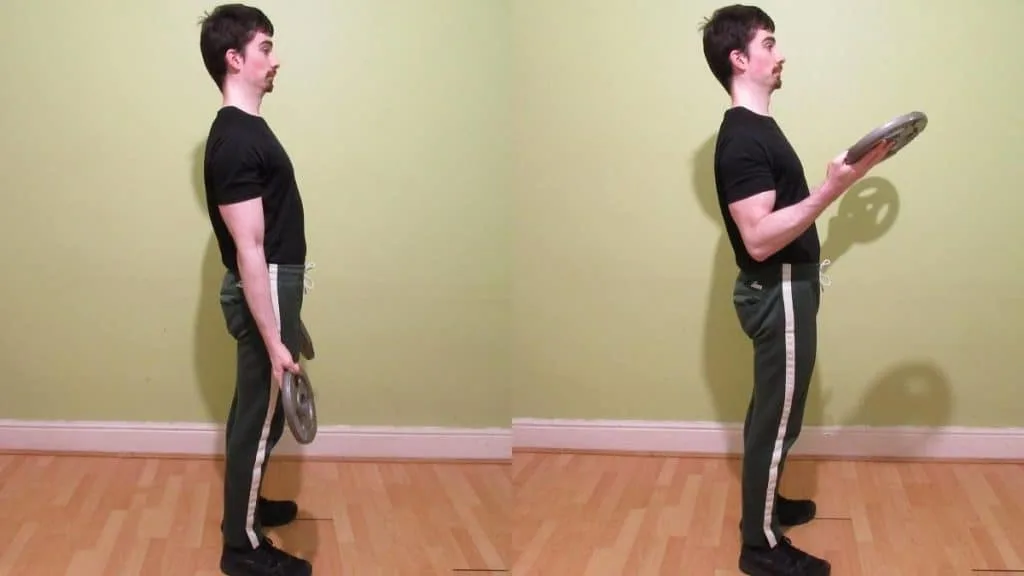
Plate curls are one of those types of bicep curls that few lifters ever perform but which can really build your biceps and, depending on how you do them, your brachialis and brachioradialis as well.
To focus purely on your biceps, hold a weight plate in each hand and curl them up and down like you would during the different types of dumbbell curls.
If you want to do weight plate bicep curls to work your brachialis and brachioradialis as well, hold a larger weight disc by its sides with both of your hands and then curl it up and down. This variation makes an excellent finishing movement for fatiguing the remaining muscle fibers in the front of your upper arms.
- Hold a weight plate in each hand with a supinated grip.
- While keeping your elbows still, curl the discs toward your shoulders.
- Once the undersides of your forearms make forceful contact with your biceps, lower the plates back down in a slow and controlled manner.
- Repeat for 3-5 sets of 10-15 reps.
Conclusion: Which bicep curl variations are the most effective?
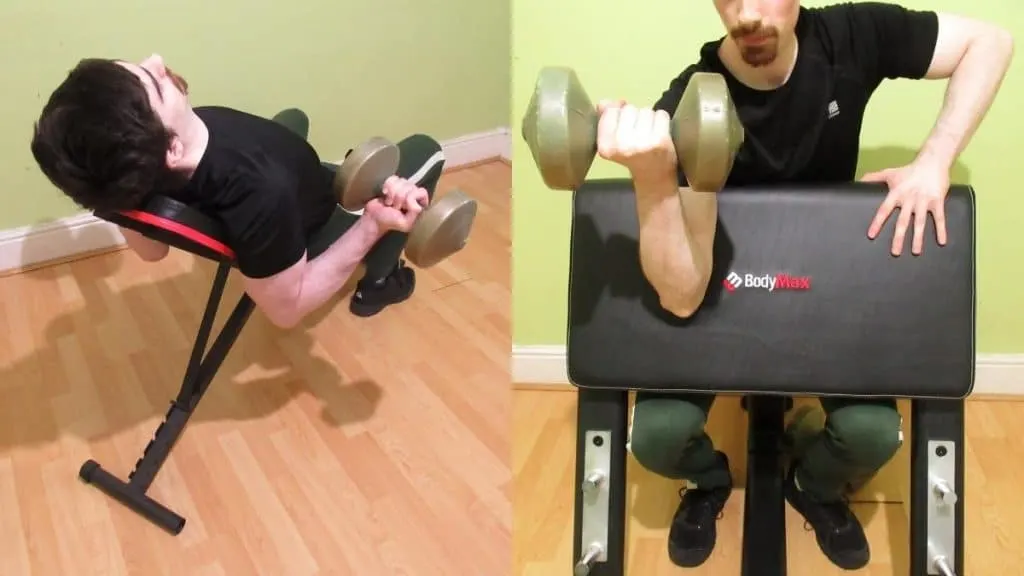
While any of the bicep curl variations that you saw above can build muscle, the best and most optimal type depends on which area of your arms you want to emphasize.
For example, to put more tension on the long (outer) head of your biceps, you want to curl with your arms slightly behind your torso, in which case incline curls and drag curls would be your best bet.
Conversely, to focus on the short (inner) head of your biceps, you want to curl with your arms in front of your body. So in this regard, movements like preacher curls and concentration curls would be optimal.
Similarly, to maximally stimulate your brachialis and brachioradialis muscles, you need to put your biceps in a position of mechanical disadvantage in which they can’t produce much force. So any exercise that uses a reverse grip—and, to a lesser extent, a neutral grip—is your best bet here.

